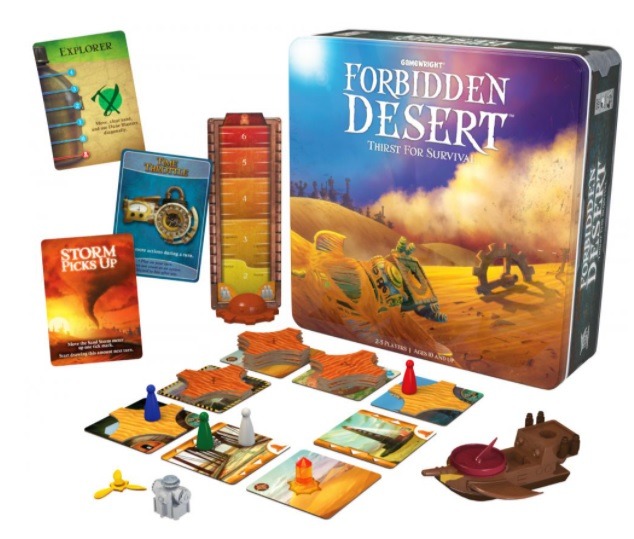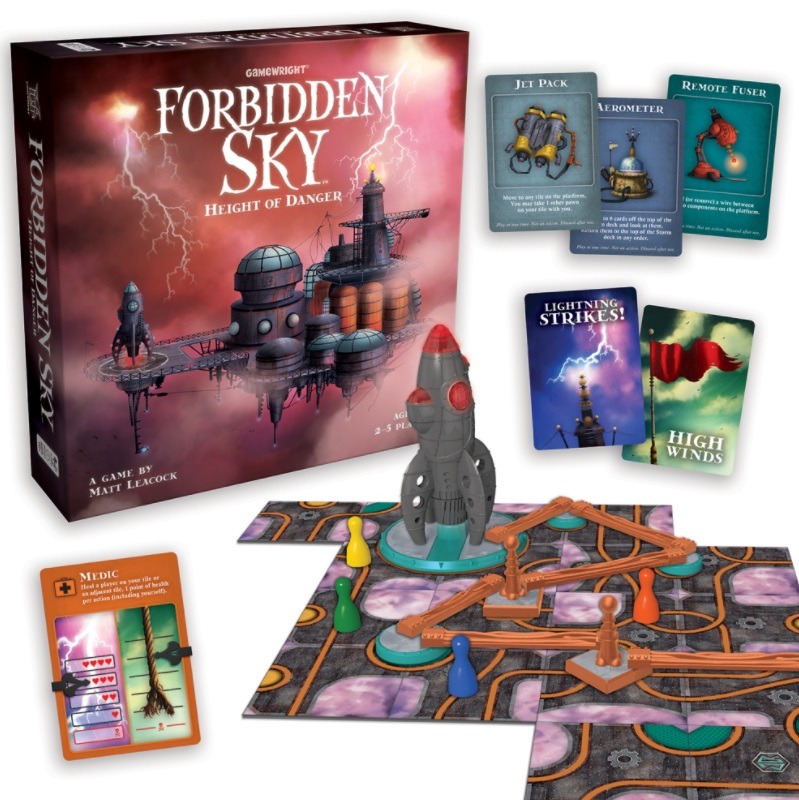I have been playing a fair amount of Forbidden Island recently. As I have said in my Forbidden Island review, I think it’s a well-designed game and I am enjoying it. So I was curious if there is something more on offer – and sure there is. Forbidden Island has received two “sequels“: Forbidden Desert and Forbidden Sky
They aren’t really sequels in a strict sense of the word, more like spiritual successors. Designed by Matt Leacock and published by Gamewright, they use the same cooperative principle of trying to achieve a common goal while fighting the game, while each of them is sufficiently different and fresh.
Titles are connected by the story-line. The helicopter you used to escape the Island, crash-lands in the Desert and you must build an ancient flying machine to escape. With this flying machine, you then fly to a secret power platform 7000ft in the air to launch a rocket, which will take you to find an ancient Archean civilization (whatever that may be).
Forbidden Desert – Thirst for Survival

In Forbidden Desert, the board is pre-build out of tiles in a 5×5 shape. What is different compared to the Island, is that here the tiles get buried in the sand instead of getting flooded by water. This is done by placing sand markers on tiles.
Like shoring flooded tiles, players can remove sand from buried tiles. Tiles are no longer removed from the board, but if they have two or more sand tokens on them, they become impassable.
Starting tiles are also placed face-down and must be excavated to show their faces. That adds a completely new aspect of exploration and brings a well-needed element of hidden information. It means there are no longer optimal moves, as you never know what you will find.
That should create a healthier discussion between players, with less chance for alpha players to dominate the decision-making. There are now 4 action points instead of 3, which further adds to the flexibility and variability of possible moves.
Setting up opportunities to share treasure cards was one of the more frustrating experiences of Forbidden Island. You had to be on the same tile and then pay one action for each card you wanted to give. You could only receive cards on opponents’ turns, which would often lead to unwanted discarding of treasure cards.
This mechanism is now completely gone. First of all, there are no treasure cards. Treasure locations (or parts of the flying machine, as they are known here) are found by excavating two of its corresponding tiles (giving coordinates in a very clever way). Now you can only transfer gear and water (it works like health points), and you can transfer both of them for free at any time, as long as you are on the same tile, of course.
Desert is Angry
Desert has several tools at its disposal to hinder your progress:
- the wind blows to move certain tiles on the board,
- more sand is added to the tiles and
- you lose water as a result of thirst.
If you draw a “Storm Picks Up” card, the storm meter will move one notch higher and you will possibly draw more storm cards in the future.
There are six adventurers with unique abilities. Abilities seem very potent. I expect them to create a unique experience with every new combination you try.
Forbidden Sky – Height of Danger

The third game in the series is also the one that appears most different. For start, the grid of tiles is not pre-build. You start with a 4×1 starting tile. The rest of the tiles are placed by the players as the game progresses.
The goal of the game is to launch a rocket. You do this by building a complete electrical circuit (how many elements must be included is dictated by the difficulty) from one side of the launch platform to the other.
The elements that make the circuit are actually conductors themselves and the rocket works on batteries – so you will know right away if the circuit is complete or not. It’s a nice touch and something that adds to the immersion.
Speaking of immersion – the theme and artwork do look less compelling than previous titles. Tiles are covered with cables and the completed board does not look like a coherent platform has been built, but rather a bunch of random tiles thrown together. The colors are in order with the theme, but the theme is not in order with previous themes – going from exploring ancient lands to now science fiction. A lot of players will be put off by that.
Sky is Angry
There are now even more ways to lose:
- losing your hit points from getting struck by lightning and
- losing your rope points from being blown away by the wind.
- You also lose if the storm meter reaches the top or if
- the rocket leaves anyone behind.
Wind can change direction and lighting rods get placed automatically (if you place a tile that has them). All that combined, I’d immediately say the game is harder to win than its predecessors. Some reviewers have marked its ability to die so suddenly and unexpectedly as not fun.
As with Desert, you also have 4 action points. They can be used to
- take a new tile,
- place a tile,
- move and
- add a wire.
You can have as many as three tiles in front of you and then decide, which one you want to place. You can also share equipment for free if you are on the same tile (they’ve kept the Desert approach here).
Adventurers’ abilities seem nicely balanced, although a healer will probably be the first choice of many.
Forbidden Sky might again be susceptible to the alpha-gamer syndrome as there are normally very few (sensible) choices on how to place tiles and build the wire circuit and there is no hidden information. If they partially addressed this in Forbidden Desert, Forbidden Sky goes back to the roots of Forbidden Island.
Which One is the Best Forbidden Game?
I really like the new gameplay mechanisms, that the Desert and the Sky bring to the table. I believe they make each game feel like its own, but still, keep enough similarities to make the series feel connected.
I believe the Desert is the better of the two and possibly even the best of the trilogy.
More cooperative board games: Best Cooperative Board Games – Top 10 List

Hello, Vasilij! I appreciate your review of Forbidden Island. While I have never played these games, it does spark an interest. Your review makes it sound like a fun and challenging game. I’m sure, as you say, the other games are similar. I might have to check them out! Thank you for the detailed review and for suggesting it!
Thank you for the comment and encouraging words!
Hello Vasilij – To answer your question, no I haven’t played the games you’ve described yet. But they sound interesting. I like sequels and continuing themes. I like the idea of not knowing what happens next with the potential to discover the outcome at some point. My favorite board game of all time is Monopoly! I’ve been involved in games that lasted into the wee hours of the morning. I’ve Googled Forbidden Island and Amazon has it. I’m going to start with that.
Thanks for the opportunity
If you like Monopoly, then you shoul definitely check out my article on top 5 editions of Monopoly and my tips for winning Monopoly.